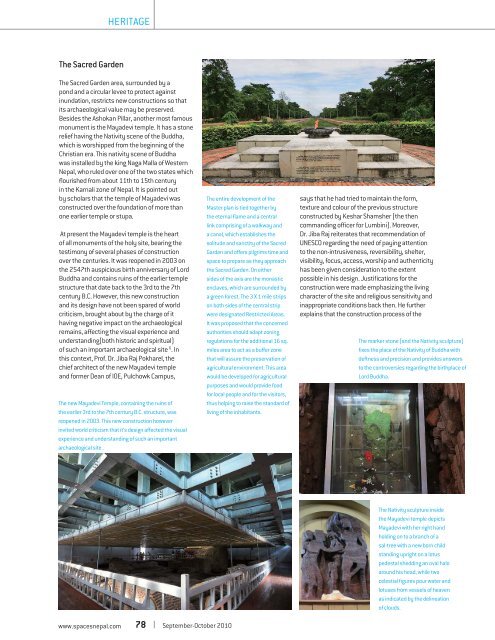5. September - October 2010
Create successful ePaper yourself
Turn your PDF publications into a flip-book with our unique Google optimized e-Paper software.
HERITAGE<br />
The Sacred Garden<br />
The Sacred Garden area, surrounded by a<br />
pond and a circular levee to protect against<br />
inundation, restricts new constructions so that<br />
its archaeological value may be preserved.<br />
Besides the Ashokan Pillar, another most famous<br />
monument is the Mayadevi temple. It has a stone<br />
relief having the Nativity scene of the Buddha,<br />
which is worshipped from the beginning of the<br />
Christian era. This nativity scene of Buddha<br />
was installed by the king Naga Malla of Western<br />
Nepal, who ruled over one of the two states which<br />
flourished from about 11th to 15th century<br />
in the Karnali zone of Nepal. It is pointed out<br />
by scholars that the temple of Mayadevi was<br />
constructed over the foundation of more than<br />
one earlier temple or stupa.<br />
At present the Mayadevi temple is the heart<br />
of all monuments of the holy site, bearing the<br />
testimony of several phases of construction<br />
over the centuries. It was reopened in 2003 on<br />
the 2547th auspicious birth anniversary of Lord<br />
Buddha and contains ruins of the earlier temple<br />
structure that date back to the 3rd to the 7th<br />
century B.C. However, this new construction<br />
and its design have not been spared of world<br />
criticism, brought about by the charge of it<br />
having negative impact on the archaeological<br />
remains, affecting the visual experience and<br />
understanding(both historic and spiritual)<br />
of such an important archaeological site 6 . In<br />
this context, Prof. Dr. Jiba Raj Pokharel, the<br />
chief architect of the new Mayadevi temple<br />
and former Dean of IOE, Pulchowk Campus,<br />
The new Mayadevi Temple, containing the ruins of<br />
the earlier 3rd to the 7th century B.C. structure, was<br />
reopened in 2003. This new construction however<br />
invited world criticism that it’s design affected the visual<br />
experience and understanding of such an important<br />
archaeological site .<br />
The entire development of the<br />
Master plan is tied together by<br />
the eternal flame and a central<br />
link comprising of a walkway and<br />
a canal, which establishes the<br />
solitude and sanctity of the Sacred<br />
Garden and offers pilgrims time and<br />
space to prepare as they approach<br />
the Sacred Garden. On either<br />
sides of the axis are the monastic<br />
enclaves, which are surrounded by<br />
a green forest. The 3 X 1 mile strips<br />
on both sides of the central strip<br />
were designated Restricted Areas.<br />
It was proposed that the concerned<br />
authorities should adapt zoning<br />
regulations for the additional 16 sq.<br />
miles area to act as a buffer zone<br />
that will assure the preservation of<br />
agricultural environment. This area<br />
would be developed for agricultural<br />
purposes and would provide food<br />
for local people and for the visitors,<br />
thus helping to raise the standard of<br />
living of the inhabitants.<br />
says that he had tried to maintain the form,<br />
texture and colour of the previous structure<br />
constructed by Keshar Shamsher (the then<br />
commanding officer for Lumbini). Moreover,<br />
Dr. Jiba Raj reiterates that recommendation of<br />
UNESCO regarding the need of paying attention<br />
to the non-intrusiveness, reversibility, shelter,<br />
visibility, focus, access, worship and authenticity<br />
has been given consideration to the extent<br />
possible in his design. Justifications for the<br />
construction were made emphasizing the living<br />
character of the site and religious sensitivity and<br />
inappropriate conditions back then. He further<br />
explains that the construction process of the<br />
The marker stone (and the Nativity sculpture)<br />
fixes the place of the Nativity of Buddha with<br />
deftness and precision and provides answers<br />
to the controversies regarding the birthplace of<br />
Lord Buddha.<br />
The Nativity sculpture inside<br />
the Mayadevi temple depicts<br />
Mayadevi with her right hand<br />
holding on to a branch of a<br />
sal-tree with a new born child<br />
standing upright on a lotus<br />
pedestal shedding an oval halo<br />
around his head, while two<br />
celestial figures pour water and<br />
lotuses from vessels of heaven<br />
as indicated by the delineation<br />
of clouds.<br />
www.spacesnepal.com 78<br />
<strong>September</strong>-<strong>October</strong> <strong>2010</strong>

















